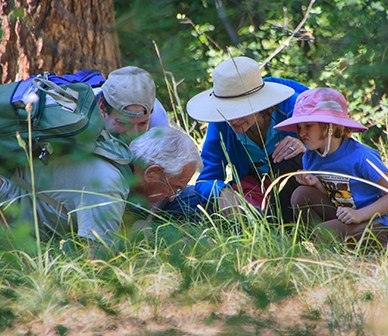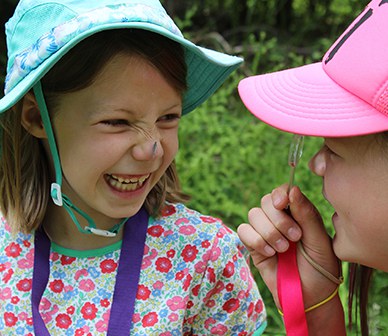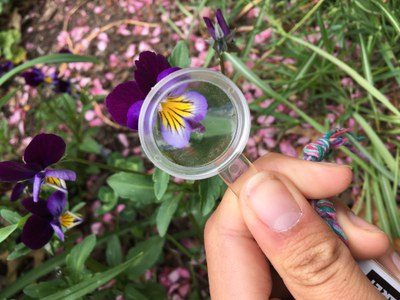This post is wonderful for all ages, but is exceptionally interesting for elementary ages. Gather your young folks or those who are young in spirit and read along:
There is no limit to the number of things we can discover, explore, and learn about our natural world. Just when you start to think you know everything there is to know about a certain creature, plant, or place—think again!
While sometimes observing our world from a distance helps us see important things, like the way a bird may use a dead tree as its home. Getting up close and personal with nature and observing the details can reveal things we might not have noticed before.
Use a hand lens to reveal critters, creatures, and new kinds of growth. Rocks that may have seemed drab and grey suddenly come to life when you look at them up close. Allowing ourselves to see the world differently lights up our imagination and builds our curiosity. Taking a hand lens hike this season can be the perfect way to bring new excitement to familiar adventures with your kids.
How to use your hand lens:
Step 1.
Remember, a hand lens is a tool for scientific discovery and exploration. When using a hand lens you have the opportunity to explore entire worlds of things you might not have seen before. Taking care of your hand lens and being sure to use your hand lens responsibly means you will have the chance to make many more discoveries in the future.
Step 3. Because your hand lens is up to your eye, you will need to situate yourself so that you can get your specimen in focus. Focusing your hand lens brings what you are looking at into view and gives you a clear and magnified picture. If you can hold the object you are looking at (try with your fingerprint, a pinecone, or a small rock) bringing it closer and further away from your eye will help to find the “sweet spot.” If the object you are observing cannot be moved (try this with the bark of a tree) you will need to lean in and move your head so that the object comes into focus.
Step 4. Say WOAH! Once you have found the “sweet spot” of your hand lens and have focused your specimen, you have unlocked the ability to discover a whole new part of nature. Maybe the lichen growing on a tree looks like an alien forest when you are using your hand lens. Perhaps you are able to see things that you might not have ever been able to see before!
When you begin discovering new worlds up close, remember that those worlds have been there long before you found them. By leaving these discoveries the way we found them we give future explorers the chance to find them as we did. Doing what you can to not disturb them helps to continue growing healthily as a part of our natural world.
Caregivers + Parents:
Taking the chance to look up close at something in nature, gives you the chance to encourage and ignite curiosity in your child. Get excited before your child begins to get excited, looking through your own hand lens and saying “wow, woah, oh my goodness” will only make your child want to look at their own even more. As your child begins to make discoveries be sure to ask questions about the details of their observation. Asking about color, shape, and texture are great ways to get a conversation started; and asking your child what the discovery reminds them of is a great way to spark even more questions. Bringing along a hand lens is an easy and fun way to add a whole new perspective to hikes, parks, or areas you’ve already explored and is a great way to dive into learning about new places. Who knows, you might even discover something new yourself!
Learn More:
- Join the Deschutes Land Trust on a family-friendly walk or hike!
- How to spark a sense of wonder in your family.
- Tips for an excellent butterfly expedition!


